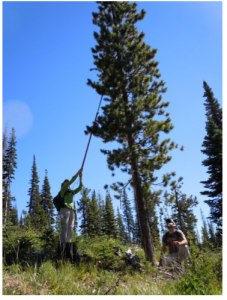Conifers vs. Rockfish
I come to the Adaptree project with a background in marine biology, and I thought I’d take this opportunity to talk about conifer life-history traits. Conifers share some amazing parallels with marine species, but particularly with one of my favorites: the Pacific rockfish (Sebastes spp.). What better way to highlight some of the challenges of studying conifer biology than by comparing them to something that lives in the ocean?
Lodgepole pine (Pinus contorta)
Copper rockfish (Sebastes caurinus)
1. Both produce a large number of gametes.
A single mature lodgepole pine in a seed orchard tree can produce 800 cones, and each cone may contain 45 seeds. A single tree can produce 16,000 seeds in a single year! After seeds are fertilized, the cones will close and the cones will stay on the tree for about a year, allowing the seeds to develop. Similarly, rockfish brood eggs for about a month, before releasing larvae in the open ocean. A single rockfish may brood over 1,000,000 eggs!
2. Both have gametes or offspring that have high dispersal potential.
Pictured on the left is a pollen grain (less than 100μm), and on the right is a rockfish larvae (a few mm). Pollen is transported by wind, and the “Mickey Mouse” ears on the pollen grain are actually air sacs that add bouyancy, keeping the pollen grain up in the air. Likewise, rockfish larvae are transported by ocean currents anywhere from a few weeks to a few months, before settling into rocky habitats. These life history traits result in high gene flow. One of the challenges of studying conifer biology is understanding how different amounts of gene flow between the sexes (pollen travels long distances by wind, whereas seed dispersal is relatively low) may constrain or promote adaptation to the environment.
3. Juveniles have a low survival probability.
Both conifers and rockfish have what are known has Type III survivorship: of all the millions of seeds (or in the case of rockfish, larvae) that are produced every year, probably only a few survive to reproduce.
4. Both are slow to reproduce.
A typical pine tree may take from 5 to 15 years to start producing cones. Rockfish are very similar, and don’t reach reproductive maturity for 8-15 years. This life-history makes both susceptible to overharvesting, because it takes a long time for natural populations to rebound.
5. Both are long-lived, and age can be measured by rings!
Can you tell which picture is from an adult tree and which from a juvenile rockfish? (hint: zoom in to see the scale).
Rockfish, like all teleost fishes, have inner ear-bones called otoliths that—just like conifers—form rings on a yearly basis. In both conifers and rockfish, these rings can be counted to indicate age. Whereas a rockfish may live up to a hundred years (pretty long for a fish), a conifer may live up to a few hundred years, or even a few thousand! The longevity of these populations, in combination with a long time to reach maturity, makes it harder for us scientists to study directly how these populations evolve.
6. Both have large population sizes.
Large population sizes—in the millions for most species of conifers and rockfish—means that there is a lot of genetic variation on which selection may act. Although, effective populations size—the actual amount of genetic variation—may be orders of magnitude smaller than actual population size. Effective population size is one of the key factors that determines whether organisms become adapted to their environment: the larger the effective size, the more likely adaptation (although this also depends on gene flow). Populations with small effective size may drift away from their optimum.
7. Both are heavily harvested and managed.
Rockfish have been harvested over the last century, but most heavily during the 1980’s. In contrast, conifer populations in B.C. have been harvested for over two centuries. Luckily conifer seeds can be re-planted—but will the current management schemes for re-planting be productive under climate change? One of the goals of the Adaptree project is to understand the genetic basis of conifer adaptation to the environment, so that this information can be harnessed to improve management and reforestation.




